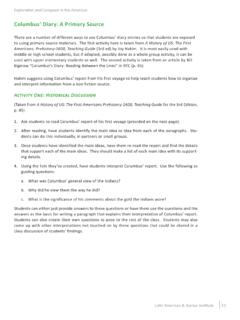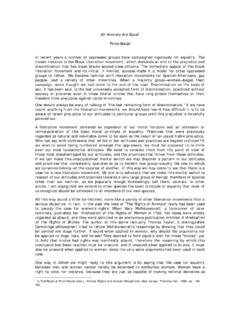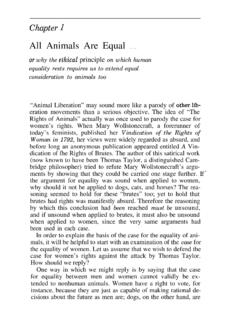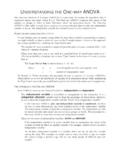Transcription of Separate is Never Equal Educators Guide
1 An Educator s Guide to Separate Is Never Equal : Sylvia Mendez & Her Family s Fight for DesegregationEDUCATOR S GUIDEPRODUCED BY THE CONSORTIUM FOR LATIN AMERICAN STUDIES PROGRAMSWRITTEN BY KATRINA DILLON 2An Educator s Guide to Separate Is Never Equal : Sylvia Mendez & Her Family s Fight for DesegregationACKNOWLEDGMENTSABOUT THIS GUIDEThis educator s Guide was written to support using Separate is Never Equal : Sylvia Mendez & Her Family s Fight for Desegregation in elementary and middle school classrooms. Produced by the Consortium of Latin American Studies Programs (CLASP) on behalf of the Am ricas Award, it was written in 2015 by Katrina Dillon, a project assistant at the University of New Mexico. Editorial support was also provided by UNM graduate assistant Alice THE AM RICAS AWARDCLASP founded the Am ricas Award in 1993 to encourage and commend authors, illustrators and publish-ers who produce quality children s and young adult books that portray Latin America, the Caribbean, or Latinos in the United States, and to provide teachers with recommendations for classroom use.
2 CLASP offers up to two annual book awards, together with a commended list of titles. For more information con-cerning the Am ricas Award, including additional classroom resources, please visit the CLASP awards are administered by CLASP and coordinated by both Tulane University s Stone Center for Latin American Studies and Vanderbilt University s Center for Latin American Studies. Generous support is also provided by Florida International University, Stanford University, The Ohio State University, University of Florida, University of New Mexico, University of Utah, and the University of CLASPCLASP s mission is to promote all facets of Latin American studies throughout the world. Its broad range of activities include the encouragement of research activities, funding of professional workshops, advancement of citizen outreach activities, and development of teaching aids for the Educator s Guide to Separate Is Never Equal : Sylvia Mendez & Her Family s Fight for DesegregationTABLE OF CONTENTSO verview.
3 4 Applicable Common Core State Standards ..6 About Author and Illustrator Duncan Tonatiuh ..7 Author s Note ..7 Classroom Relevance and Applications ..9 Lesson Plans and Activities ..11 Vocabulary ..11 Activity I: Vocabulary Study (Cognitive Content Dictionary) ..11 Activity 2: Sentence Illustration: The Importance of Prefixes ..12 Pre-Reading Activities ..13 Activity 1: Observation Charts ..13 Activity 2: Picture Walk ..14 Activity 3: Non-Fiction Genre 4: Think, Pair, Share: Equality, Segregation, Justice ..15 Guided Reading Questions ..16 Post-Reading Activities ..20 Activity 1: Comprehension Check ..20 Activity 2: Dear Sylvia ..20 Activity 3: Acrostic Poetry ..21 Activity 4: Persuasive Writing ..21 Multimedia Resources ..23 Featured Lesson Plans and Resources ..24 Complementary Literature ..25 Appendix ..35 Images from the Book ..364An Educator s Guide to Separate Is Never Equal : Sylvia Mendez & Her Family s Fight for DesegregationOVERVIEWS eparate is Never Equal : Sylvia Mendez & Her Family s Fight for DesegregationWritten and illustrated by Duncan TonatiuhPublished 2015 by Abrams Books for Young ReadersISBN 1-4197-1054-0 THEMESS egregation, Inequality, Injustice, Civil Rights Movement, Activism, Human Rights, Legal System, History, Latino History in the United States, Education, Family, CommunitySYNOPSIS Almost 10 years before Brown vs.
4 Board of Education, Sylvia Mendez and her parents helped end school segregation in California. An American citizen of Mexican and Puerto Rican heritage who spoke and wrote perfect English, Mendez was denied enrollment to a Whites only school. Her parents took action by organizing the Hispanic community and filing a lawsuit in federal district court. Their success eventually brought an end to the era of segregated education in California. View the book trailer for Separate is Never Equal : Sylvia Mendez & Her Family s Fight for Desegregation produced by the Texas Bluebonnet LEVELG rades 1-5 / Ages 7-12 REVIEWS Tonatiuh masterfully combines text and folk-inspired art to add an important piece to the mosaic of civil rights history. Kirkus Reviews, starred review5An Educator s Guide to Separate Is Never Equal : Sylvia Mendez & Her Family s Fight for Desegregation Children will understand the importance of the 1947 ruling that desegregated California schools, paving the way for Brown v.
5 Board of Education seven years later School Library Journal Tonatiuh (Pancho Rabbit and the Coyote) offers an illuminating account of a family s hard-fought legal battle to desegregate California schools in the years before Brown v. Board of Education. Publishers Weekly Pura Belpr Award winning Tonatiuh makes excellent use of picture-book storytelling to bring attention to the 1947 California ruling against public-school segregation. Booklist The straightforward narrative is well matched with the illustrations in Tonatiuh s signature style, their two-dimensional perspective reminiscent of the Mixtec codex but collaged with paper, wood, cloth, brick, and (Photoshopped) hair to provide textural variation. This story deserves to be more widely known, and now, thanks to this book, it will be. The Horn Book MagazineAWARDS Am ricas Award Winner 2015 Pura Belpr Award, Honor, Illustrator 2015 Tom s Rivera Mexican American Children s Book Award 2015 IRA Notable Books for a Global Society Winner 2015 NCTE Orbis Pictus Honor Book 2015 Robert F.
6 Sibert Medal, Honor Book 2015 ALA Notable Books for Children, Middle Readers 2015 Jane Addams Award Winner, Young Readers 2015 SLJ Best Books, Nonfiction 2014 Kirkus Reviews Best Books of 2014, Picture Books Center for the Study of Multicultural Children s Literature, Best Multicultural Books of 2014 New York Public Library, 100 Titles for Reading and Sharing, Nonfiction 2014 Cybils Awards Finalist, Nonfiction for Elementary & Middle Grades 20146An Educator s Guide to Separate Is Never Equal : Sylvia Mendez & Her Family s Fight for DesegregationAPPLICABLE COMMON CORE STATE STANDARDSK-12 ReadingKey Ideas and Details Read closely to determine what the text says explicitly and to make logical inferences from it; cite specific textual evidence when writing or speaking to support conclusions drawn from the text. Determine central ideas or themes of a text and analyze their development; summarize the key supporting details and ideas. Analyze how and why individuals, events, and ideas develop and interact over the course of a and Structure Interpret words and phrases as they are used in a text, including determining technical, connotative, and figurative meanings, and analyze how specific word choices shape meaning or tone.
7 Analyze the structure of texts, including how specific sentences, paragraphs, and larger portions of the text ( , a section, chapter, scene, or stanza) relate to each other and the whole. Assess how point of view or purpose shapes the content and style of a of Reading and Level of Text Complexity Read and comprehend complex literary and informational texts independently and of Knowledge and Ideas Integrate and evaluate content presented in diverse media and formats, including visually and quantitative-ly, as well as in WRitingText Types and Purposes Write arguments to support claims in an analysis of substantive topics or texts, using valid reasoning and relevant and sufficient evidence. Write informative/explanatory texts to examine and convey complex ideas and information clearly and accurately through the effective selection, organization, and analysis of and Distribution of Writing Produce clear and coherent writing in which the development, organization, and style are appropriate to task, purpose, and audience.
8 Develop and strengthen writing as needed by planning, revising, editing, rewriting, or trying a new to Build and Present Knowledge Conduct short as well as more sustained research projects based on focused questions, demonstrating un-derstanding of the subject under investigation. Gather relevant information from multiple print and digital sources, assess the credibility and accuracy of each source, and integrate the information while avoiding plagiarism. Draw evidence from literary or informational texts to support analysis, reflection, and Educator s Guide to Separate Is Never Equal : Sylvia Mendez & Her Family s Fight for DesegregationDUNCAN TONATIUH: AUTHOR AND ILLUSTRATOR ABOUT TONATIUHD uncan Tonatiuh (toh-nah-tyou) is an award-winning author and illustrator. Tonatiuh was born in Mexico City and grew up in San Miguel de Allende. In 2008 he received his BFA from Parsons School of Design and his BA from Eugene Lang College, both divisions of the New School University in New York City.
9 His work is inspired by ancient Mexican art, particularly that of the Mixtec codex. His aim is to create images that honor the past, but that address contemporary issues that affect people of Mexican origin on both sides of the addition to Separate Is Never Equal : Sylvia Mendez & Her Family s Fight for Desegregation, Tonatiuh has published three other children s books, all to notable acclaim. Pancho Rabbit and the Coyote: A Migrant s Tale received an honorable mention from both the 2014 Am rica s Award and the 2014 Pura Belpr . Diego Rivera: His World and Ours won the 2012 Pura B lpre illustration award and the 2012 Tomas Rivera Mex-ican-American Children s book Award. In addition, his first book, Dear Primo: A Letter to My Cousin, received an honorable mention from the Pura Belpr Award in 2011 and was named an Am ricas Award Commended Title and included on the Notable Book for a Global Society List. If you would like to learn more about the author, including his other books and awards, visit his S NOTEIn the 1940s, segregation based on race or national origin was common throughout the United States.
10 The Mendez v. Westminster School District case paved the way for the desegregation of schools in America. After the Mendez lawsuit, similar suits were filed and won in Texas and Arizona. In 1954, seven years after the Mendez victory, the landmark case Brown v. Board of Education desegregated schools in the entire country. Two people who played key roles in the Brown case had also been involved in the Mendez case: Thurgood Marshall and Earl Warren. As a member of the National Association of the Advancement of Colored Peo-ple, Marshall had sent friend-of-the-court briefs to the judge in the Mendez case. In these letters he argued against segregation. He later used several of the same arguments when he became the lawyer in the Brown case. Earl Warren was the governor who signed into law the desegregation of schools in California after the Mendez s victory. He later became the chief justice of the Supreme Court. He presided over the Brown case and ruled in Brown s favor.









